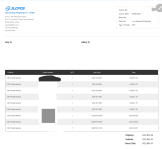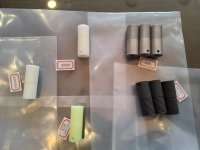I'd like to make a few simple changes to an existing .stl file I have, but I don't want to invest a lot of time learning a tool since I don't plan on doing this often, or at all, again. I tried a few apps from the Google play store, but found them unintuituve. Any suggestions? I don't mean to sound lazy, but 3d printing is not a rabbit hole I want to go down. (Once modified, I plan on having jlcpcb do the printing.)
Are you stuck with an STL or can you get access to the actual model such as STEP, IGES, Parasolid, etc.? STL is really more like the dumb husk of a CAD model so they aren't very amenable to modification. Is it something super organic in shape that can't be easily mocked up in a proper CAD format for post conversion to STL?
STL files are simply lists of triangle vertices in either a text or binary format. This makes them very easy to read, process and write which I think was the original point back in the 80s. It's even easier with a package from your favourite scripting language, for example for python, but most scripting languages are likely to have something similar.
Or do you want to do modify your models interactively and graphically with a CAD package? If so most CAD packages can import STL files but because they are more of an output format manipulation is likely to be limited. Translating, rotating, scaling,... the whole model is likely to be supported but manipulating different components and parts less so. There is software around that can seek to recover solid models from the bunch of small triangles (I worked on some about 30 years ago) but it isn't necessarily going to be 100% perfect.
Or do you want to do modify your models interactively and graphically with a CAD package? If so most CAD packages can import STL files but because they are more of an output format manipulation is likely to be limited. Translating, rotating, scaling,... the whole model is likely to be supported but manipulating different components and parts less so. There is software around that can seek to recover solid models from the bunch of small triangles (I worked on some about 30 years ago) but it isn't necessarily going to be 100% perfect.
A couple of notes: The included angle based on the drawing comes out to 118 degrees and change. If you need it to be exactly 120 then the driving dimensions will have to change too.
The 4-40 hole diameter is not specified so I went with 0.112" which is supposedly the nominal diameter of that screw. Also the drawing shows threads for the 4-40 but the STL is a smooth bore. I used smooth bore as well.
I ended up making 3 versions. V1 as dimensioned in the PDF. V2 at 120deg. And V3 at 120deg with flats included plus chamfered corners--it's closest to the original STL plus chamfers.
STEP files are included so you can modify and export to STL in FreeCAD or whatever CAD platform you choose.
The 4-40 hole diameter is not specified so I went with 0.112" which is supposedly the nominal diameter of that screw. Also the drawing shows threads for the 4-40 but the STL is a smooth bore. I used smooth bore as well.
I ended up making 3 versions. V1 as dimensioned in the PDF. V2 at 120deg. And V3 at 120deg with flats included plus chamfered corners--it's closest to the original STL plus chamfers.
STEP files are included so you can modify and export to STL in FreeCAD or whatever CAD platform you choose.
Attachments
Normal drill size for #4-40 is .089". Also, I have never seen a 3d printed hole that was round, so it's probably not a good idea to go bigger than that.The 4-40 hole diameter is not specified so I went with 0.112" which is supposedly the nominal diameter of that screw.
jeff
order placed! I choose to print all 3 STEP files using 3 different printing methods. I can't get over how inexpensive they are. About $1/part for the SLA and other plastic print type. Only the metal, 316L, ju,pedal in price but still under $20! I had a machine ship quote me $255 for one piece, hopefully this goes well.


order received! I haven't checked them out yet, but the process was painless. I had 3 nearly identical files to print (thanks again @Haze Head ). and I tried 3 processes. Black is SLS Nylon process using 3201PA-F Nylon. Gray is SLM(Metal) 316L Stainless Steel. The other 3 are SLA resin using LEDO 6060 Resin, 9000R Resin, 8228 Resin.


Nice! Pretty amazing they can get that to your door in such a short time. For future experiments you might check out PCBWAY's CNC machining service. I don't know if it's as affordable but it would get you a nice machined surface and aluminum can be used.
You have to realize, when you're going to machine a part, you have setup time for the turning center, programing time, and run time. This isn't ideal for a single part, better for 100's, 1000's of parts. This is why a single part is expensive.Only the metal, 316L, ju,pedal in price but still under $20! I had a machine ship quote me $255 for one piece.
jeff
I understand, I wasn't criticizing the single part machined quote, it's what I expected. I didn't expect the 3d print prices to be so low.
ugh. I just had my first experience with a word called "tolerances". right now, it is an evil word. the motor's shaft is 0.250" measured. most of the pulleys have a 0.242" bore hole. which is within the +/- 0.3mm toler... I can't even type that word now.
maybe if I am very careful using a 1/4" drill bit by HAND, I can get something that works for the plastic ones. for the metal, I can put it under a butane torch then jam it on maybe. probably not a good idea.
maybe if I am very careful using a 1/4" drill bit by HAND, I can get something that works for the plastic ones. for the metal, I can put it under a butane torch then jam it on maybe. probably not a good idea.
That's actually what you want rather than having an oversize bore. Probably go the next size down drill bit and then get a reamer for the size you want. Even .250 is too small unless you want an interference fit, which you probably don't. Maybe look for a reamer on fleabay closer to something like .251 or .252. Or just use a bigger drill bit; just realize your typical drill bit won't actually drill a round/straight hole, so the reamer is used to get that final kiss to size. As for the 316, your gonna want that puppy drilled, I doubt you'll get anywhere near the required expansion without destroying it and everything near it.
I'm having trouble finding a reamer. Looked at mcmaster, amazon, ebay, craigslist. they all seem to be tapered, metric, or exact 1/4".
I found only one, on Amazon under taper pipe reamers, and that makes me hesitant.
Drill America .2520 High Speed Steel Straight Shank Chucking Reamer, DWR Series
I found only one, on Amazon under taper pipe reamers, and that makes me hesitant.
Drill America .2520 High Speed Steel Straight Shank Chucking Reamer, DWR Series
Do this search on Ebay:
250 x 1-1/2 HSS STRAIGHT CHUCKING 1/4 REAMER COBALT [OAL: 6] (QTY: 1) USA NOS
That is probably about just about right for what you need. Do the first pass with the .250 and see if that is what you want. Then step up to the .2508 if needed. Also, unless you have a decent drill press and a quality vise to hold the 316 you may run into a lot of difficulty. Maybe consider having someone with the right gear do it for you. If you pop by any old metal shop and provide the bit and or reamer they can probably give you a good deal because they don't have to worry about dulling their good bits. Just a thought.
I checked on different GD&T class fits BTW. The range for a shaft/hole non interference fit was from .250 to .2516, with .2508 being at the loose end of Class II fit. They are calling .250 a non interference fit but that is highly dubious as the shaft and hole would have to be literally perfect.
.2508" 6 Flute Carbide Straight Flute Reamer MF02031167
also:250 x 1-1/2 HSS STRAIGHT CHUCKING 1/4 REAMER COBALT [OAL: 6] (QTY: 1) USA NOS
That is probably about just about right for what you need. Do the first pass with the .250 and see if that is what you want. Then step up to the .2508 if needed. Also, unless you have a decent drill press and a quality vise to hold the 316 you may run into a lot of difficulty. Maybe consider having someone with the right gear do it for you. If you pop by any old metal shop and provide the bit and or reamer they can probably give you a good deal because they don't have to worry about dulling their good bits. Just a thought.
I checked on different GD&T class fits BTW. The range for a shaft/hole non interference fit was from .250 to .2516, with .2508 being at the loose end of Class II fit. They are calling .250 a non interference fit but that is highly dubious as the shaft and hole would have to be literally perfect.
Last edited:
- Home
- Design & Build
- Software Tools
- Looking for an easy way to modify an STL file